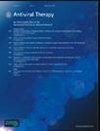利匹韦林加钴司他体达芦那韦替代标准三药疗法治疗艾滋病毒感染、病毒抑制受试者:PROBE 2试验的最终结果。
IF 2.3
4区 医学
Q4 INFECTIOUS DISEASES
引用次数: 0
摘要
背景24周时的初步分析表明,在病毒抑制的艾滋病毒感染者中,改用利匹韦林加达芦那韦/cobicstat并不劣于继续使用标准的三药抗逆转录病毒疗法。我们提供了48周分析的疗效和安全性数据。方法2是一项随机、开放标签的试验。接受三种药物治疗且至少6个月内HIV-1 RNA拷贝数<50个/mL的成年人被随机分配(1:1)至25 mg利匹韦林加800/150达芦那韦/钴司他,每日一次(早期切换组)或在切换前继续其方案24周(晚期切换组)。在48周的分析中,疗效终点是HIV-RNA拷贝数<50个/mL的参与者比例(美国食品药品监督管理局快照算法)。该试验在ClinicalTrials.gov上注册,编号为NCT04064632。招募并随机分配了FINDINGS160名参与者。在第48周,早期切换组70人(87.5%)和晚期切换组76人(94.8%)的HIV-RNA<50拷贝/mL。早期切换组的任何患者和晚期切换组的2名受试者均未出现病毒学失败(≥50个HIV-RNA拷贝数/mL),均未出现治疗引发的耐药性相关突变。早期转换组有7名(8.7%)参与者发生了导致治疗中断的不良事件,晚期转换组没有发生。解释利匹韦林联合达芦那韦/柯比司他联合用药可维持病毒学抑制,与病毒学失败频率低相关,且具有良好的安全性,这支持其作为三种药物方案的核苷逆转录酶抑制剂保留和整合酶抑制剂保留替代方案使用。本文章由计算机程序翻译,如有差异,请以英文原文为准。
Rilpivirine plus cobicistat-boosted darunavir as alternative to standard three-drug therapy in HIV-infected, virologically suppressed subjects: Final results of the PROBE 2 trial.
BACKGROUND
Primary analysis at 24 weeks showed that switching to rilpivirine plus darunavir/cobicistat was non-inferior to continuing a standard three-drug antiretroviral regimen in virologically suppressed people with HIV. We present efficacy and safety data from the 48-week analysis.
METHODS
PROBE 2 is a randomized, open-label trial. Adults who were on a three-drug therapy and had had <50 HIV-1 RNA copies/mL for at least 6 months were randomly assigned (1:1) to 25 mg rilpivirine plus 800/150 darunavir/cobicistat once daily (early switch group) or to continue their regimen for 24 weeks before switching (late switch group). In the 48-week analysis, the efficacy endpoint was the proportion of participants with <50 copies/mL of HIV-RNA (US Food and Drug Administration snapshot algorithm). The trial is registered with ClinicalTrials.gov, number NCT04064632.
FINDINGS
160 participants were recruited and randomized. At week 48, 70 (87.5%) in the early switch group and 76 (94.8%) in the late switch group maintained HIV-RNA <50 copies/mL. Virological failure (≥50 HIV-RNA copies/mL) was not seen in any patient of the early switch group and in 2 subjects in the late switch group none of which had treatment emergent resistance-associated mutation. Adverse events leading to treatment discontinuation occurred in 7 (8.7%) participants in the early switch group and in none in the late switch group.
INTERPRETATION
The combination of rilpivirine plus darunavir/cobicistat sustained virological suppression, was associated with a low frequency of virological failure, and had a favorable safety profile, which support its use as a nucleoside reverse transcriptase inhibitor-sparing and integrase inhibitor-sparing alternative to three-drug regimens.
求助全文
通过发布文献求助,成功后即可免费获取论文全文。
去求助
来源期刊

Antiviral Therapy
医学-病毒学
CiteScore
2.60
自引率
8.30%
发文量
35
审稿时长
4-8 weeks
期刊介绍:
Antiviral Therapy (an official publication of the International Society of Antiviral Research) is an international, peer-reviewed journal devoted to publishing articles on the clinical development and use of antiviral agents and vaccines, and the treatment of all viral diseases. Antiviral Therapy is one of the leading journals in virology and infectious diseases.
The journal is comprehensive, and publishes articles concerning all clinical aspects of antiviral therapy. It features editorials, original research papers, specially commissioned review articles, letters and book reviews. The journal is aimed at physicians and specialists interested in clinical and basic research.
 求助内容:
求助内容: 应助结果提醒方式:
应助结果提醒方式:


